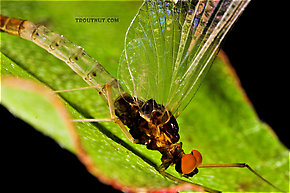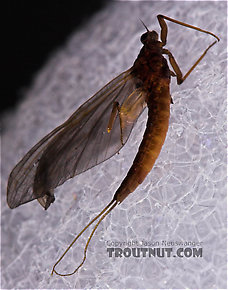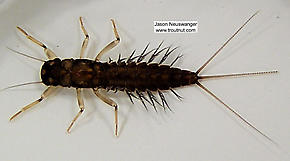Blog & Latest Updates
Fly Fishing Articles
Insects by Common Name


Mayfly Genus Paraleptophlebia (Blue Quills and Mahogany Duns)
Taxonomic Navigation -?-
Kingdom
Animalia (Animals)
» Phylum
Arthropoda (Arthropods)
» Class
Insecta (Insects)
» Order
Ephemeroptera (Mayflies)
» Genus Paraleptophlebia (Blue Quills and Mahogany Duns)
20 species aren't included.
Common Names
In the East and Midwest, their small size (16 to 20, but mostly 18's) makes them difficult to match with old techniques. In the 1950s Ernest Schwiebert wrote in Matching the Hatch:
"The Paraleptophlebia hatches are the seasonal Waterloo of most anglers, for without fine tippets and tiny flies an empty basket is assured."
Fortunately, modern anglers with experience fishing hatches of tiny Baetis and Tricorythodes mayflies are better prepared for eastern Paraleptophlebia. It's hard to make sense of so many species, but only one is very important and others can be considered in groups because they often hatch together:
- Paraleptophlebia adoptiva is by far the most important species of this genus in the two regions and is an early Spring emerger.
- Paraleptophlebia mollis, Paraleptophlebia guttata, and Paraleptophlebia strigula complement each other in late spring and early summer.
- Paraleptophlebia debilis and Paraleptophlebia praepedita occur together in the fall.
- The most important species is Paraleptophlebia debilis. This large (for the genus) Fall emerger can be found throughout the region. It is often accompanied by one of the slightly larger tusked species. Depending on locale, this can be Paraleptophlebia bicornuta (the most common), Paraleptophlebia packii or Paraleptophlebia helena. Check out their hatch pages for distribution information.
- Spring is the season for the smaller Paraleptophlebia heteronea throughout most of the region with Paraleptophlebia gregalis filling this niche in California and parts of Oregon.
Hatching Behavior
Though usually noted for migrating to the shallows to hatch, most species at times emerge in classic mayfly style on the surface and ride the water for a while before flying away. This is exacerbated by the inclement weather they often hatch in. Floating nymph patterns and emergers are very effective at these times. The hatch may last for a few hours each day.
George Edmunds in Mayflies of North and Central America documented that Paraleptophlebia mayflies have been observed to emerge by crawling out onto shore when the water is high in the Spring, but since he gives no further details about which species do this it is reasonable to assume it's generic. Knopp and Cormier note in Mayflies: An Angler's Study of Trout Water Ephemeroptera the same behavior.
Spinner Behavior
Time Of Day: Weather dependant
Habitat: Soft margins
According to Edmunds, the females will mate more than once and often proceed to shoreline foliage when finished with ovipositing as opposed to dying spent (Spent: The wing position of many aquatic insects when they fall on the water after mating. The wings of both sides lay flat on the water. The word may be used to describe insects with their wings in that position, as well as the position itself.) on the water. The males start the swarms first, often well before. They are often observed along the shoreline dipping from six to two feet and rising again. On occasion, many males for unknown reasons drop to the water at this time and become trapped in the meniscus. When the females finally arrive, they join them quickly at the top, copulate during the four foot fall, and just as quickly make short dives to either dip their abdomens into the water or land on the water to lay their eggs. Then it's up and back at it until they're finished. Edmunds reports that they will repeat this cycle as many as three times before they occasionally die spent (Spent: The wing position of many aquatic insects when they fall on the water after mating. The wings of both sides lay flat on the water. The word may be used to describe insects with their wings in that position, as well as the position itself.) on the water or more often head back to the bushes. This is good information for the angler to note.Habitat: Soft margins
Nymph Biology
Current Speed: Moderate to fast
Substrate: Sand, gravel, detritus (Detritus: Small, loose pieces of decaying organic matter underwater.)
Although classified as crawlers, Paraleptophlebia nymphs look more like little burrowers (especially the tusked variety) and swim very well. They are generally tolerant of faster water than Leptophlebia and inhabit pockets in riffles as well as moderate runs.Substrate: Sand, gravel, detritus (Detritus: Small, loose pieces of decaying organic matter underwater.)
Pictures of 30 Mayfly Specimens in the Genus Paraleptophlebia:
Male Paraleptophlebia (Blue Quills and Mahogany Duns) Mayfly Spinner View 15 PicturesI wasn't actually fishing the river where I caught this one. I was just scouting, didn't like the look of the water, and as I was walking back to the car this little dun landed on my vest. Why can't they all be so easy to collect?
View 15 PicturesI wasn't actually fishing the river where I caught this one. I was just scouting, didn't like the look of the water, and as I was walking back to the car this little dun landed on my vest. Why can't they all be so easy to collect?
 View 15 PicturesI wasn't actually fishing the river where I caught this one. I was just scouting, didn't like the look of the water, and as I was walking back to the car this little dun landed on my vest. Why can't they all be so easy to collect?
View 15 PicturesI wasn't actually fishing the river where I caught this one. I was just scouting, didn't like the look of the water, and as I was walking back to the car this little dun landed on my vest. Why can't they all be so easy to collect?Collected September 8, 2006 from the East Branch of the Delaware River in New York
Added to Troutnut.com by Troutnut on October 4, 2006
Added to Troutnut.com by Troutnut on October 4, 2006
Female Paraleptophlebia (Blue Quills and Mahogany Duns) Mayfly Dun View 4 PicturesI really hoped to catch some good blue quill specimens on this trip, but they are very fragile mayflies and this one was in the best condition of the few that I caught after I drove them home to my camera. It may not be pretty, but you get an idea of the size/shape/color anyway.
View 4 PicturesI really hoped to catch some good blue quill specimens on this trip, but they are very fragile mayflies and this one was in the best condition of the few that I caught after I drove them home to my camera. It may not be pretty, but you get an idea of the size/shape/color anyway.
 View 4 PicturesI really hoped to catch some good blue quill specimens on this trip, but they are very fragile mayflies and this one was in the best condition of the few that I caught after I drove them home to my camera. It may not be pretty, but you get an idea of the size/shape/color anyway.
View 4 PicturesI really hoped to catch some good blue quill specimens on this trip, but they are very fragile mayflies and this one was in the best condition of the few that I caught after I drove them home to my camera. It may not be pretty, but you get an idea of the size/shape/color anyway.Collected April 19, 2006 from the Beaverkill River in New York
Added to Troutnut.com by Troutnut on April 21, 2006
Added to Troutnut.com by Troutnut on April 21, 2006
Paraleptophlebia (Blue Quills and Mahogany Duns) Mayfly Nymph View 4 Pictures
View 4 Pictures
 View 4 Pictures
View 4 PicturesCollected March 9, 2004 from Big Brook in Wisconsin
Added to Troutnut.com by Troutnut on January 25, 2006
Added to Troutnut.com by Troutnut on January 25, 2006
Recent Discussions of Paraleptophlebia
Western Paraleptophlebia 17 Replies »
Paul wrote in another topic:
I largely agree, though they seem to be more tolerant of current than most genera of leptophlebiids. I have sampled them from riffles. In my experience (with an admitted western bias), they are far more important in the Fall. If an angler is lucky enough to be in place (and aware of them) when they are schooled up in preparation for hatching, some memorable nymphing can take place! :)
P. adoptiva is an eastern species. By far the most important species in the West is P. debilis, though they can be found mixed with others, particularly the unusual tusk bearing species bicornuta and in some locales packii. Anglers that occasionally come across these tuskers often confuse them with the immature burrowing ephemerids they resemble. Many anglers use their standard nymphs and do just fine with them. The PT is a popular pattern. Sometimes, a nymph that more accurately suggests their silhouette is the ticket. Because of their build and very obvious gills, they look more like a small long-tailed burrower than they do the typical baetid or ephemerellid, and it is good for the angler to keep this in mind.
Most duns and spinners are typically a rich brown, hence the name "Mahogany Dun." They can run the gamut from gray to almost black though, depending on the location. The slender bodies and coloration of the duns lead to them often being mistaken for baetids, but the oval vertically held hind wings and three tails make them easy to distinguish from that family. Check out this link to the hatch page for a look at the natural dun.
http://www.troutnut.com/hatch/752/Mayfly-Paraleptophlebia-debilis-Mahogany-Dun
Below are a couple of patterns I find very useful when this critter is about.
Mahogany Dun Nymph #16
(User-posted images are only viewable in the forum section.)
(User-posted images are only viewable in the forum section.)
Mahogany Paradun #16
(User-posted images are only viewable in the forum section.)
ReplyParalep Hatching Behavior 9 Replies »Yes, the Paraleps can come about the same time as the tricaudatus, but don't start as early I think. And I think they were a mid-morning deal where tricaudatus has more of an afternoon peak. (Here in the rockies we're not supoosed to don't have the early P adoptiva, although last spring I found a single youngish nymph that my key would only take it to adoptiva -by gills if I remember right. Wish I'd pickled it and had it properly ID'd.
Anyway, back east I found the Paraleps emerged from slower currents and siltier substrates -often along stream edges. Whereas tricaudatus spilled out of the riffles. They could mix of course in certain places, but one could find one predominant if you wanted to (and I did bc I wanted to know each better), by focusing on key habitat.
Fly patterns could be identical really, although I had my own, esp for the nymphs. In fact, I'm still using some P adoptiva mimic parachutes (more a dun gray) during Baetis activity.
I largely agree, though they seem to be more tolerant of current than most genera of leptophlebiids. I have sampled them from riffles. In my experience (with an admitted western bias), they are far more important in the Fall. If an angler is lucky enough to be in place (and aware of them) when they are schooled up in preparation for hatching, some memorable nymphing can take place! :)
P. adoptiva is an eastern species. By far the most important species in the West is P. debilis, though they can be found mixed with others, particularly the unusual tusk bearing species bicornuta and in some locales packii. Anglers that occasionally come across these tuskers often confuse them with the immature burrowing ephemerids they resemble. Many anglers use their standard nymphs and do just fine with them. The PT is a popular pattern. Sometimes, a nymph that more accurately suggests their silhouette is the ticket. Because of their build and very obvious gills, they look more like a small long-tailed burrower than they do the typical baetid or ephemerellid, and it is good for the angler to keep this in mind.
Most duns and spinners are typically a rich brown, hence the name "Mahogany Dun." They can run the gamut from gray to almost black though, depending on the location. The slender bodies and coloration of the duns lead to them often being mistaken for baetids, but the oval vertically held hind wings and three tails make them easy to distinguish from that family. Check out this link to the hatch page for a look at the natural dun.
http://www.troutnut.com/hatch/752/Mayfly-Paraleptophlebia-debilis-Mahogany-Dun
Below are a couple of patterns I find very useful when this critter is about.
Mahogany Dun Nymph #16
(User-posted images are only viewable in the forum section.)
(User-posted images are only viewable in the forum section.)
Mahogany Paradun #16
(User-posted images are only viewable in the forum section.)
I can't remember where I read or heard these things (might have been on this site), but I want to make sure my vague recollections are not totally false. When Paraleptophlebia are mating, do they make exaggerated dives in clouds above the stream? If so, do they often end up in the water at these times or do they fall as spinners much later? Finally, when they emerge, do they do so at the stream bottom and then swim to the surface as duns?
Thanks for any help,
Shawn
ReplyThanks for any help,
Shawn
Your Thoughts On Paraleptophlebia:
Top 10 Fly Hatches
Top Gift Shop Designs
Eat mayflies.
Top Insect Specimens
Miscellaneous Sites
Troutnut.com is copyright © 2004-2024 Jason
Neuswanger (email Jason). See my FAQ for information about use of my images.
 privacy policy
privacy policy
